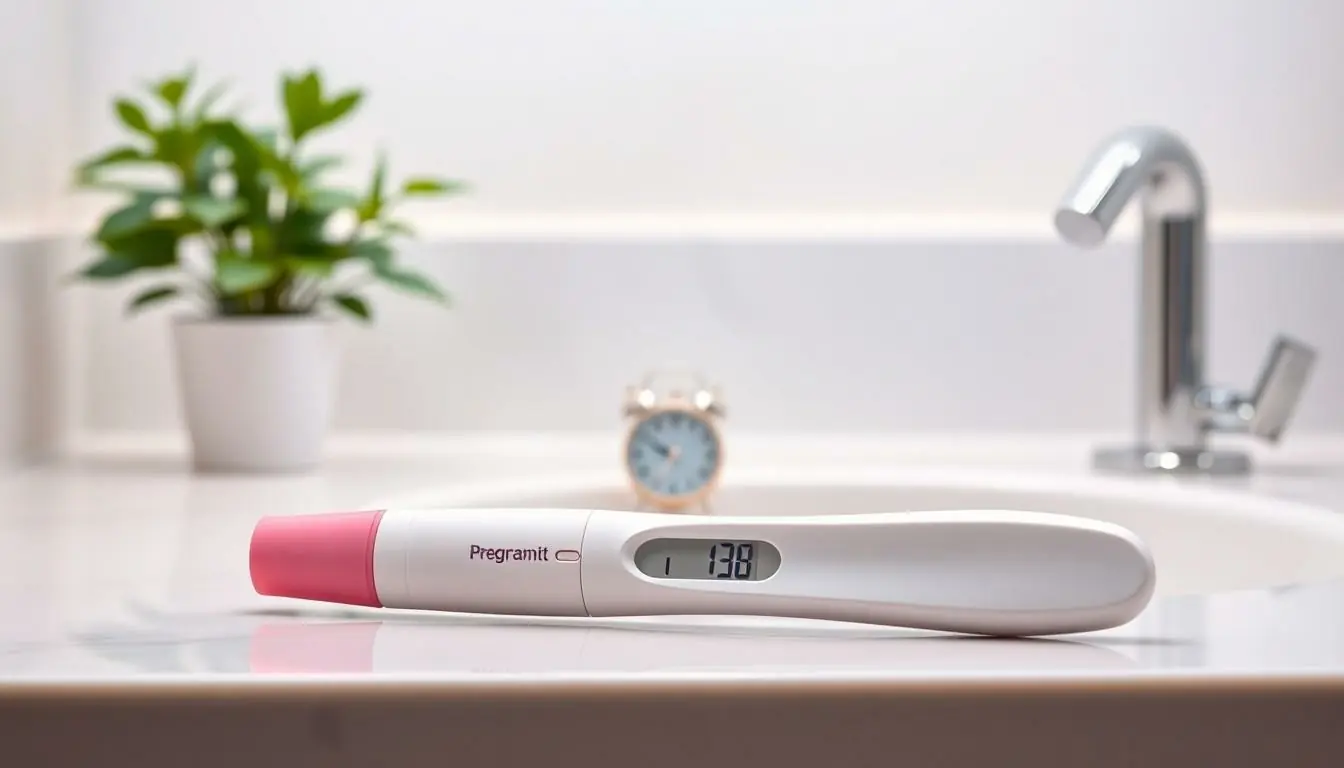Table of Contents
ToggleWaiting to take a pregnancy test can feel like an eternity, especially when curiosity strikes at midnight. Many women find themselves staring at that little test box in their bathroom cabinet, wondering if they should wait until morning or just go for it right then and there.
The pregnancy testing journey can be nerve-wracking enough without adding timing concerns to the mix. While conventional wisdom suggests morning testing is best, modern pregnancy tests have evolved significantly. Today’s tests offer remarkable accuracy, leading many to question whether the time of day really matters as much as we’ve been led to believe.
How Pregnancy Tests Work
Pregnancy tests detect the presence of human chorionic gonadotropin (hCG) hormone in urine or blood. These tests provide a positive or negative result based on specific hCG threshold levels.
Understanding HCG Hormone Levels
HCG appears in the bloodstream 7-10 days after fertilization when a fertilized egg implants in the uterus. The hormone levels double every 48-72 hours during early pregnancy, reaching peak concentrations at 8-11 weeks. Modern pregnancy tests detect hCG levels as low as 25 mIU/mL, while some sensitive tests identify levels of 10 mIU/mL.
| Pregnancy Timeline | HCG Levels (mIU/mL) |
|---|---|
| 3-4 weeks | 5-426 |
| 4-5 weeks | 18-7,340 |
| 5-6 weeks | 1,080-56,500 |
| 6-7 weeks | 7,650-229,000 |
Types of Pregnancy Tests Available
Home pregnancy tests include digital tests with electronic displays or traditional tests with line indicators. Digital tests provide clear “pregnant” or “not pregnant” results within 3 minutes. Traditional line tests show one line for negative results two lines for positive results. Blood tests conducted at medical facilities offer two options: qualitative tests that confirm pregnancy quantitative tests that measure exact hCG levels. Laboratory blood tests detect pregnancy earlier than urine tests picking up hCG levels as low as 5 mIU/mL.
Best Time to Take a Pregnancy Test
Early morning urine contains the highest concentration of hCG hormone, making it the optimal time for pregnancy testing. The concentration levels affect test accuracy significantly during early pregnancy detection.
First Morning Urine vs Night Testing
First morning urine (FMU) provides more concentrated hCG levels due to limited fluid intake during sleep. Testing with FMU reduces false negative results by detecting even small amounts of pregnancy hormone. Night testing presents challenges due to diluted urine from daily fluid intake varying hormone concentrations. Modern pregnancy tests demonstrate improved sensitivity, detecting hCG levels as low as 10 mIU/mL regardless of testing time. Digital tests offer enhanced accuracy with clear results displays compared to traditional line tests.
Ideal Waiting Period After Missed Period
Testing accuracy increases significantly 1-2 days after a missed period. The body produces detectable hCG levels reaching 50 mIU/mL at this stage. Tests conducted 7 days after a missed period show 99% accuracy rates. Early testing before a missed period increases false negative results by 25-40%. Blood tests detect pregnancy 6-8 days after ovulation, while urine tests become reliable 2 weeks after conception.
| Testing Timeline | hCG Levels (mIU/mL) | Accuracy Rate |
|---|---|---|
| Before Missed Period | 10-25 | 60-75% |
| 1-2 Days After | 50-100 | 90% |
| 7 Days After | 100-200 | 99% |
Taking a Pregnancy Test at Night
Taking a pregnancy test at night presents unique challenges due to variations in hormone concentration levels. The timing of pregnancy testing affects accuracy with nighttime results displaying specific considerations.
Accuracy Concerns with Nighttime Testing
Nighttime urine contains lower concentrations of hCG compared to first-morning samples. Studies indicate that evening urine samples show 25-50% less concentrated hCG levels than morning samples. This dilution occurs from fluid intake throughout the day, creating potential accuracy issues for early pregnancy detection. Digital pregnancy tests require a minimum of 25 mIU/mL of hCG for accurate results, while diluted evening urine may fall below this threshold. The reduced hormone concentration increases the risk of false-negative results, particularly during the earliest stages of pregnancy when hCG levels remain low.
Tips for Night Testing
Limiting fluid intake 4 hours before testing improves urine concentration for more accurate results. A 4-hour urine hold creates conditions similar to first-morning urine by allowing hCG to accumulate. Using high-sensitivity pregnancy tests rated at 10 mIU/mL detection levels enhances accuracy for evening testing. Testing multiple nights in succession confirms results through consistent readings. Storing unopened pregnancy tests at room temperature between 36-86°F maintains test reliability. Checking expiration dates ensures test strip effectiveness during nighttime use.
Common Mistakes When Testing
Pregnancy test accuracy depends on proper testing techniques. Several common errors can lead to inaccurate results when conducting home pregnancy tests.
Diluted Urine Effects
Excessive fluid intake dilutes urine concentration levels up to 50% compared to first-morning samples. Drinking large amounts of water 4 hours before testing reduces hCG hormone levels below detectable thresholds. Caffeinated beverages like coffee tea or soda increase urine production creating more diluted samples. Medical studies show diluted urine samples generate false-negative results in 30% of early pregnancy tests. Testing with concentrated urine samples improves accuracy rates by maintaining sufficient hCG levels for detection.
Reading Results Too Early or Late
Test results require specific time windows for accurate interpretation based on manufacturer guidelines. Reading results before 3 minutes leads to false negatives as the testing strip needs time to react with hCG hormones. Examining results after 10 minutes produces invalid outcomes due to evaporation lines appearing on test strips. Digital pregnancy tests display error messages when read outside designated timeframes. Laboratory data indicates 25% of home pregnancy test errors occur from improper result timing. Test manufacturers specify optimal reading windows between 3-5 minutes for maximum accuracy.
Getting the Most Accurate Results
Maximizing pregnancy test accuracy requires careful attention to timing, technique, and proper test interpretation. Following specific guidelines ensures reliable results regardless of testing time.
Following Test Instructions
Each pregnancy test brand includes detailed manufacturer instructions that outline specific steps for accurate results. Opening the test package only when ready to use prevents contamination from moisture or environmental factors. The testing process involves collecting urine in a clean cup or holding the test stick directly in the urine stream for 5-7 seconds. Placing the test on a flat surface during development prevents invalid results from movement or tilting. Digital tests display clear “positive” or “negative” readings while traditional tests require comparing lines to the reference guide.
When to Repeat the Test
Repeating a pregnancy test increases result confidence in specific situations. A second test 24-48 hours after an initial negative result allows time for hCG levels to increase if pregnant. Testing after 7 days from a missed period provides 99% accuracy due to higher hormone concentrations. Multiple negative results with persistent pregnancy symptoms indicate the need for medical consultation. Taking consecutive tests using different brands eliminates potential manufacturing defects affecting accuracy.
Conclusion
Taking a pregnancy test at night is possible with modern testing technology but comes with increased risks of inaccurate results. While morning testing remains the gold standard due to higher hCG concentration levels women who choose nighttime testing can improve accuracy by limiting fluid intake and using high-sensitivity tests.
The key to reliable results lies in following proper testing procedures careful timing and correct result interpretation. For those unable to wait until morning limiting fluid intake for several hours before testing and using first-response tests can provide more reliable results.
Remember that testing after a missed period significantly increases accuracy regardless of the time of day. When in doubt it’s always best to confirm results with a morning test or consult a healthcare provider.





